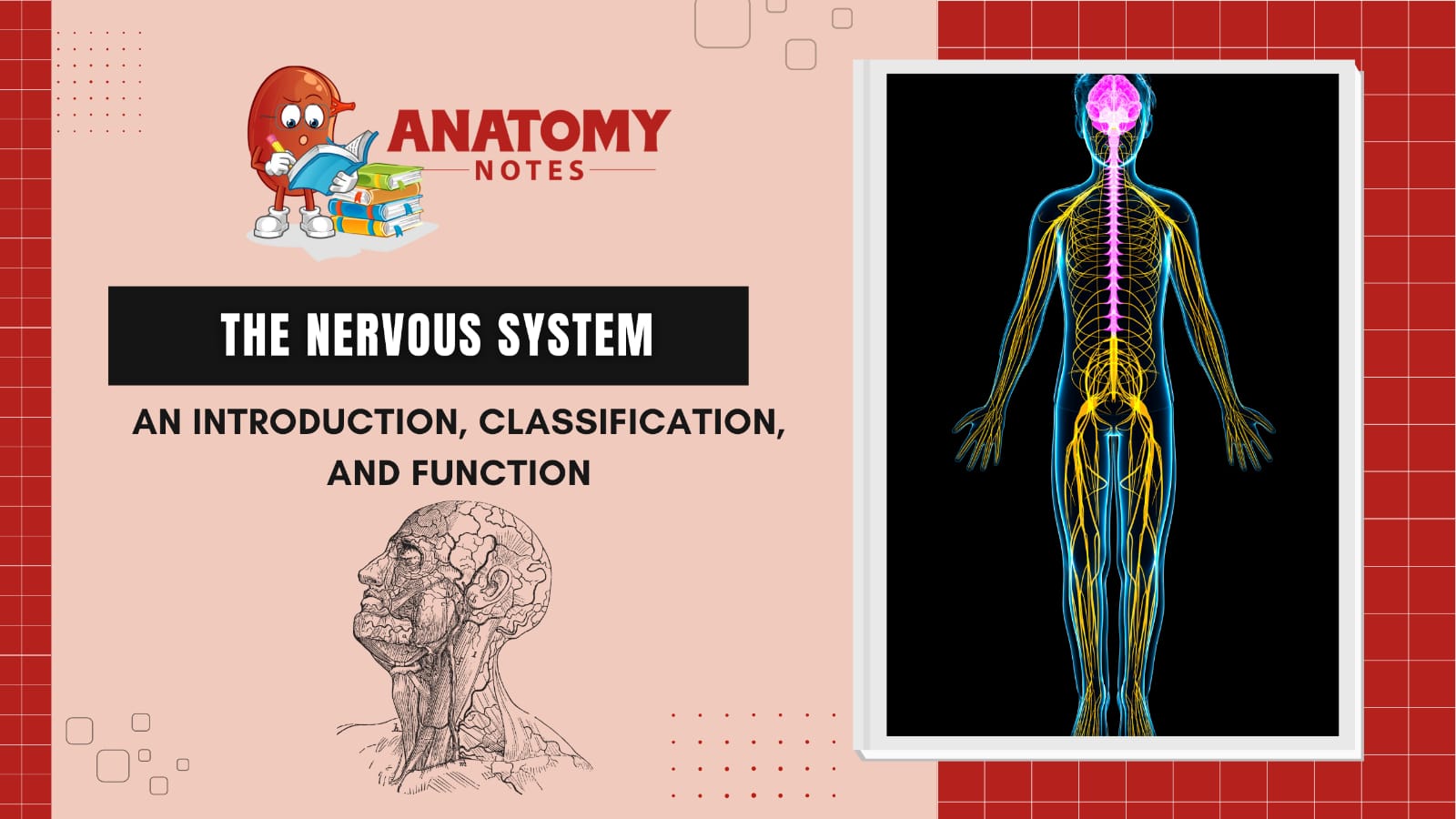The nervous system is the combination of the brain, spinal cord and the complex network of neurons. This system performs and responsible for various functions like sending, receiving, and interpreting information from all parts of the body.
The nervous system also responsible for monitoring and coordinates the internal organ function and responds to changes in the external environment.
The nervous system derives its name from nerves, which are cylindrical bundles of fibers (the axons of neurons), that emanate from the brain and spinal cord, and branch repeatedly to innervate every part of the body.
This system is divided into two parts i.e. The central and the peripheral nervous system.
- Central nervous system – It is composed of the brain and spinal cord that received, process and send the information to the peripheral nervous system. This system has a protective covering of bone.
- Peripheral nervous system– It consists of cranial nerves, spinal nerves and billions of sensory and motor neurons. The peripheral nervous system provides a pathway of communication between the central nervous system and the rest of the body, this is also a primary function of the peripheral nervous system. This system has exposed nerves and more vulnerable to injury.
Also Read :
Human Reproductive system- Formation of Gametes, Organs Overview and Function
https://anatomynotes.org/reproductive-system/human-reproductive-system-formation-of-gametes-organs-overview-and-function/
The peripheral nervous system is divided into the following sections:
- Sensory Nervous System—sends information to the CNS from internal organs or from external stimuli.
- Motor Nervous System—carries information from the CNS to organs, muscles, and glands.
- Somatic Nervous System—controls skeletal muscle as well as external sensory organs.
- Autonomic Nervous System—controls involuntary muscles, such as smooth and cardiac muscle.
- Sympathetic—control activities that increase energy expenditures.
- Parasympathetic—control activities that conserve energy expenditures.
- Enteric—controls digestive system activity.
Functions of the nervous system –
- The nervous system is involved in receiving information about the environment around us (sensation) and generating responses to that information (motor responses).
- This system can be divided into regions that are responsible for sensation (sensory functions) and for the response (motor functions). But there is a third function that needs to be included. Sensory input needs to be integrated with other sensations, as well as with memories, emotional state, or learning (cognition).
- Some regions of the nervous system are termed integration or association areas. The process of integration combines sensory perceptions and higher cognitive functions such as memories, learning, and emotion to produce a response.
- The first major function of the nervous system is sensation—receiving information about the environment to gain input about what is happening outside the body (or, sometimes, within the body).
- The sensory functions of the nervous system register the presence of a change from homeostasis or a particular event in the environment, known as a stimulus.
- The senses we think of most are the “big five”: taste, smell, touch, sight, and hearing. The stimuli for taste and smell are both chemical substances (molecules, compounds, ions, etc.), touch is physical or mechanical stimuli that interact with the skin, sight is light stimuli, and hearing is the perception of sound, which is a physical stimulus similar to some aspects of touch.
- There are actually more senses than just those, but that list represents the major senses. Those five are all senses that receive stimuli from the outside world, and of which there is conscious perception.
- Additional sensory stimuli might be from the internal environment (inside the body), such as the stretch of an organ wall or the concentration of certain ions in the blood.
- This system produces a response on the basis of the stimuli perceived by sensory structures. An obvious response would be the movement of muscles, such as withdrawing a hand from a hot stove, but there are broader uses of the term.
- This system can cause the contraction of all three types of muscle tissue. For example, skeletal muscle contracts to move the skeleton, cardiac muscle is influenced as heart rate increases during exercise, and smooth muscle contracts as the digestive system move food along the digestive tract.
- Responses also include the neural control of glands in the body as well, such as the production and secretion of sweat by the eccrine and merocrine sweat glands found in the skin to lower body temperature.
- Responses can be divided into those that are voluntary or conscious (a contraction of skeletal muscle) and those that are involuntary (a contraction of smooth muscles, regulation of cardiac muscle, activation of glands).
- Voluntary responses are governed by the somatic nervous system and involuntary responses are governed by the autonomic nervous system, which is discussed in the next section.
- Stimuli that are received by sensory structures are communicated to the nervous system where that information is processed.
- This is called integration. Stimuli are compared with, or integrated with, other stimuli, memories of previous stimuli, or the state of a person at a particular time.
- This leads to a specific response that will be generated. Seeing a baseball pitched to a batter will not automatically cause the batter to swing.
- The trajectory of the ball and its speed will need to be considered.
- Maybe the count is three balls and one strike, and the batter wants to let this pitch go by in the hope of getting a walk to first base. Or maybe the batter’s team is so far ahead, it would be fun to just swing away.
Learn More:
Frequently Asked Questions (FAQs)
What is the nervous system?
The intricate system of cells and tissues that communicate signals between various regions of the body is referred to as the nervous system. It is responsible for controlling and coordinating bodily functions, including sensory perception, movement, and cognitive processes such as memory and emotion.
What are the 3 types of nervous system?
The three types of nervous system are:
- Central nervous system (CNS): The CNS, which comprises the brain and spinal cord, carries out the tasks of processing and combining information.
- Peripheral nervous system (PNS): Consists of all the nerves outside the CNS and is responsible for transmitting signals between the CNS and the rest of the body.
- Autonomic nervous system (ANS): A division of the PNS that regulates involuntary bodily functions such as heart rate, digestion, and breathing. The autonomic nervous system (ANS) can be classified into two separate systems, namely the sympathetic nervous system and the parasympathetic nervous system.
What is the main role of nervous system?
The main role of the nervous system is to control and coordinate the activities of the body. It does this by transmitting electrical and chemical signals between different parts of the body, including the brain, spinal cord, and peripheral nerves. The nervous system is responsible for many important bodily functions, including movement, sensation, perception, learning, memory, and emotion. It also regulates and maintains homeostasis, which is the balance of internal conditions in the body, such as temperature, pH, and blood pressure.
Which nervous system is important?
The central nervous system (CNS) is particularly crucial as it consists of the brain and spinal cord, which are responsible for processing and integrating information from the body’s senses and coordinating motor responses. The peripheral nervous system (PNS) is also vital as it connects the CNS to the rest of the body, allowing for communication and control. The autonomic nervous system (ANS), a division of the PNS, regulates many vital bodily functions such as heart rate, digestion, and breathing. So, each nervous system has its own unique and important role in the overall function of the body.
What are the 5 roles of the nervous system?
The nervous system has many functions, but some of the main ones include:
- Sensory input: The nervous system gathers information from the body’s internal and external environments through sensory receptors.
- Integration: The nervous system processes and interprets the sensory input to determine the appropriate response.
- Motor output: The nervous system responds to sensory input by activating the appropriate effectors (muscles or glands) to produce a response.
- Homeostasis: The nervous system helps to maintain a stable internal environment by regulating physiological processes such as temperature, blood pressure, and heart rate.
- Higher functions: The nervous system is also responsible for more complex cognitive processes such as perception, learning, memory, and emotion.
What are nervous system disorders?
Nervous system disorders are a group of conditions that affect the function and/or structure of the nervous system. They can affect any part of the nervous system, including the brain, spinal cord, peripheral nerves, and autonomic nervous system.





Thank you for the above summary of the nervous system and its parts. It is a fascinating, well explained simple summary.
Much appreciated
Christina